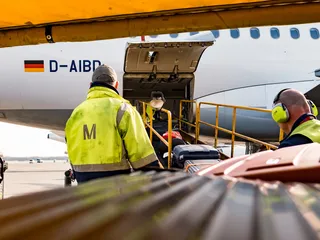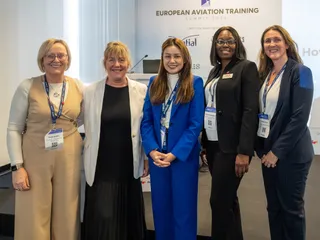EASA’s Focus on Ground Handling Workforce SMSs is Gaining Speed
Contact Our Team
For more information about how Halldale can add value to your marketing and promotional campaigns or to discuss event exhibitor and sponsorship opportunities, contact our team to find out more
The Americas -
holly.foster@halldale.com
Rest of World -
jeremy@halldale.com

An advantages we enjoy at Halldale Group is the ability to monitor training and safety activities across the broad high-risk community – from safety critical industries to defense to civil aviation -- and comment on them.
One activity on our watchlist noted the new EU Ground Handling safety regulations are effective and will become applicable from 27 March 2028. The landmark regulations have huge implications, as they will start the transformation of the European ground handling (GH) workforce which includes more than 300,000 professionals.
Through 2028 EASA is hosting a series of webinars to help the European GH industry prepare for the implementation of the new GH safety rules. This 23 September, the author virtually viewed the second webinar in the series. Major webinar topics included the management system, focus on safety management systems (SMS), industry standards, and alleviations in the rules for small GH organizations – important content for enterprises refining or implementing EASA-compliant SMSs. Indeed, the author suggests that the scope and breadth of topics offered in this webinar series may be of value to safety professionals who are developing SMSs for their unique use cases beyond civil aviation.
An extract of the 23 September webinar is contained in this article.
Deliberate Process
While this second EASA webinar in the series was not advertised as a “how to construct a safety management system,” the four panelists provided vital insights and suggestions to individuals implementing SMSs, with a laser-like focus on the front-end of the process.
The webinar members brilliantly managed expectations of those enhancing or constructing SMSs for the GH sector.
Most important, there was a general concurrence among the webinar members that it is a long journey to build an effective and relevant SMS – with a realistic horizon of one-to-two (and possibly more) years. The group opined that a deliberately-paced build process must meet the requirements of stakeholders, from GH workforce members to the GH sector company to regulatory authorities. There were several comments on a crystal-clear reality facing safety professionals and their enterprises, be it airlines, GH workforce providers and others: civil aviation is a for-profit endeavor. Yet, the webinar panelists held the line on the reality that safety must co-exist and even be a priority in this economic model.
And the desired end product? An SMS that is “living” and not tucked away on a shelf following the end of the first cycle.
Early Challenges and Lessons Learned
EASA moderators asked the panel members to share their early challenges and lessons learned on their SMS implementation journey.
IBAC’s Terry Yeomans, Program Director, International Standard for Business Aircraft Handling (IS-BAH), noted his organization has a two-year, oversight cycle as part of its voluntary GH program. He explained the major challenge is whether to put the SMS “on the shelf” after a cycle, and do nothing with it, and expect it to go away. “That is the biggest challenge – when you properly run your SMS it becomes part of what you do. If it is too difficult and challenging, the system has been set up incorrectly. You may need to go back to your foundation, build on it and start moving forward. The other big thing we see are safety performance indicators that are not relevant to your operation. The content you are capturing and measuring must bring you value.”
Jonathan Heavey, Ground Operations Inspector at Irish Aviation Authority, emphasized SMS is a “walk-before-you-run” process. As a regulator’s representative he told webinar viewers he will be looking to see what the organization is doing and how it is creating the SMS. “It is important to say that us, as competent authorities, have zero expectations that you will have this as a ‘bells and whistles’ management system on Day 1 – and not even Year 1, 2 or 3. This is a system that has to build up slowly. What we’ll also initially be seeking is how you are doing – have you embraced SMS? What, for example, are you doing to: promote and report information; and also gain correct information relevant to your operation.” The IAA official encouraged organizations to scale and build SMSs to their own capacity. “Do a survey to start to find out what your ground handlers know about safety culture, a ‘just culture’ and about the SMS process – get that information in,” he offered.
SMSs are certainly not designed to be a one-size-fit-all proposition. Burkhardt Höfer, Executive Vice-President Commercial, Hamburg Ground Handling GmbH, Hamburg Airport. offered his organization’s successes were due in large part to taking a well-written, overarching SMS from the host airport and tailoring the GH issues for his purposes. “At end of the day it worked out but it took a while.” As significant, he further encouraged smaller size organizations to similarly reach out to gain the support and advice of community colleagues who have successfully implemented the build of an SMS. “The collaborative approach is the right one.”
Swissport’s Clark offered suggestions very applicable to any, but in particular, a large, organization. The industry veteran emphasized the imperatives of communication and outreach within the enterprise to achieve success. Reflecting from past experience on an internal program that was not fully implemented, he specifically encouraged webinar attendees to “bring people along, communicate, conduct webinars, hold additional training” and complete other tasks to create an SMS. “This is really about investing time and other resources to bring people along with you to learn about these elements of SMS,” and concurred with previous webinar statements that suggested tailoring SMS to organizations.
Data, Again
Measurement. Check. Correct information as a SNA foundation. Check. These and other requirements in the SMS build process require data. Indeed, panelist Höfer observed, “there is a lot of data,” and noted one opportunity to use this content to build key performance indicators (KPIs). “We need to better learn how to use this data to extract the right KPIs and manage safety better. We need a little more creativity to get better data to manage the system.”
On our Watchlist
EASA has a solid plan in place to advance the safety and readiness of the European GH community, in part, through the establishment of SMSs and related processes. CAT will be following the community’s journey to conform with these new EASA regulations.
The 23 September video is expected to be available before the end of this week on EASA’s YouTube channel Together4Safety.
Initial queries on the EASA GH SMS process may be sent to ground-handling@easa.europa.eu.


